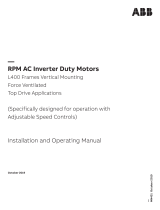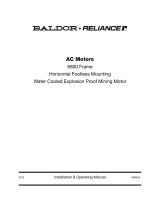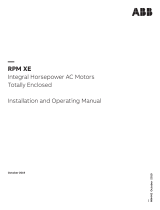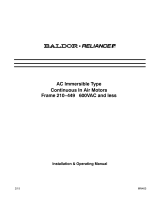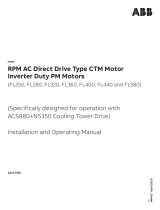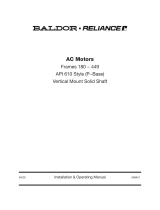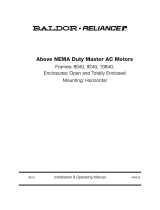Page is loading ...

—
MN414 May 2020
May 2020
—
AC Submersible Pump Motors
Installation and Operating Manual

Any trademarks used in this manual are the property of their respective owners.
Important:
Be sure to check www.baldor.com for the latest software, rmware and drivers for your ECM product. Also, you can
download the latest version of this manual in Adobe Acrobat PDF format.
Note: Baldor Electric Company, became ABB Motors and Mechanical, Inc. on March 1, 2018. Nameplates,
Declaration of Conformity and other collateral material may contain the company name of Baldor Electric Company
and the brand names of Baldor-Dodge and Baldor-Reliance as well as the company name of ABB until such time as all
materials have been updated to reflect our new corporate identity of ABB.

iMN414
Table of Contents
Section 1
General Information 1−1
Overview ................................................................................ 1−1
Important: ................................................................................ 1−1
Safety Notice: ............................................................................. 1−1
Receiving ................................................................................. 1-2
Handling .................................................................................. 1-2
Section 2
Installation & Operation 2−1
Overview ................................................................................. 2−1
Installation ............................................................................... 2−2
Grounding ................................................................................. 2-3
Thermal Protection .......................................................................... 2-3
Moisture Protection .......................................................................... 2-4
Operation ................................................................................. 2-5
Lubrication ................................................................................ 2-5
Section 3
Lead Cable Connection 3−1
Use this section when applicable
Overview ................................................................................. 3−1

ii MN414

1-1MN414
Section 1
General Information
Overview This manual contains general procedures that apply to Baldor Motor products. Be sure to read and understand
the Safety Notice statements in this manual. For your protection, do not install, operate or attempt to perform
maintenance procedures until you understand the Warning and Caution statements.
A Warning statement indicates a possible unsafe condition that can cause harm to personnel.
A Caution statement indicates a condition that can cause damage to equipment.
Important: This instruction manual is not intended to include a comprehensive listing of all details for all procedures required
for installation, operation and maintenance. This manual describes general guidelines that apply to most of the
motor products shipped by Baldor. If you have a question about a procedure or are uncertain about any detail,
Do Not Proceed. Please contact your Baldor District Ofce for more information or clarication.
Before you install, operate or perform maintenance, become familiar with the following:
• NEMA Publication MG-2, Safety Standard for Construction and guide for Selection, Installation and
Use of Electric Motors and Generators.
• The National Electrical Code
• Local codes and Practices
Safety Notice: This equipment contains high voltage! Electrical shock can cause serious or fatal injury. Only qualied personnel
should attempt installation, operation and maintenance of electrical equipment.
Be sure that you are completely familiar with NEMA publication MG-2, safety standards for construction and
guide for selection, installation and use of electric motors and generators, the National Electrical Code, IEC and
local codes and practices. Unsafe installation or use can cause conditions that lead to serious or fatal injury.
Only qualied personnel should attempt the installation, operation and maintenance of this equipment.
WARNING: The Adjustable Speed Controller may apply hazardous voltages to the motor leads after power to the
controller has been turned off. Verify that the controller is incapable of delivering hazardous voltages and
that the voltage at the motor leads is zero before proceeding. Failure to observe this precaution may result
in severe bodily injury or death.
WARNING: Do not touch electrical connections before you first ensure that power has been disconnected. Electrical
shock can cause serious or fatal injury. Only qualified personnel should attempt the installation, operation
and maintenance of this equipment.
WARNING: Be sure the system is properly grounded before applying power. Do not apply AC power before you ensure
that all grounding instructions have been followed. Electrical shock can cause serious or fatal injury.
National Electrical Code and Local codes must be carefully followed.
WARNING: Avoid extended exposure to machinery with high noise levels. Be sure to wear ear protective devices to
reduce harmful effects to your hearing.
WARNING: Surface temperatures of motor enclosures may reach temperatures which can cause discomfort or injury
to personnel accidentally coming into contact with hot surfaces. Protection should be provided by the
user to protect against accidental contact with hot surfaces. Failure to observe this precaution could
result in bodily injury.
WARNING: This equipment may be connected to other machinery that has rotating parts or parts that are driven by
this equipment. Improper use can cause serious or fatal injury. Only qualified personnel should attempt to
install operate or maintain this equipment.
WARNING: Do not by-pass or disable protective devices or safety guards. Safety features are designed to prevent
damage to personnel or equipment. These devices can only provide protection if they remain operative.
WARNING: Avoid the use of automatic reset devices if the automatic restarting of equipment can be hazardous to
personnel or equipment.
WARNING: Be sure the load is properly coupled to the motor shaft before applying power. The shaft key must be
fully captive by the load device. Improper coupling can cause harm to personnel or equipment if the load
decouples from the shaft during operation.
WARNING: Use proper care and procedures that are safe during handling, lifting, installing, operating and maintaining
operations. Improper methods may cause muscle strain or other harm.
WARNING: Pacemaker danger - Magnetic and electromagnetic fields in the vicinity of current carrying carrying
conductors and permanent magnet motors can result result in a serious health hazard to persons with
cardiac pacemakers, metal implants, and hearing aids. To avoid risk, stay way from the area surrounding a
permanent magnet motor.
WARNING: Incorrect motor rotation direction can cause serious or fatal injury or equipment damage. Be sure to verify
motor rotation direction before coupling the load to the motor shaft.
WARNING: Do not use non UL/CSA listed explosion proof motors in the presence of flammable or combustible vapors
or dust. These motors are not designed for atmospheric conditions that require explosion proof operation.
WARNING: Motors that are to be used in flammable and/or explosive atmospheres must display the UL label on the
nameplate along with CSA listed logo. Specific service conditions for these motors are defined in NFPA 70
(NEC) Article 500.
WARNING: UL Listed motors must only be serviced by UL Approved Authorized Baldor Service Centers if these
motors are to be returned to a hazardous and/or explosive atmosphere.
WARNING: Thermostat contacts automatically reset when the motor has slightly cooled down. To prevent injury or
damage, the control circuit should be designed so that automatic starting of the motor is not possible
when the thermostat resets.

1-2 MN414
Safety Notice Continued
Caution: To prevent equipment damage, be sure that the electrical service is not capable of delivering more than
the maximum motor rated amps listed on the rating plate.
Caution: If a HI POT test (High Potential Insulation test) must be performed, follow the precautions and procedure in
NEMA MG1 and MG2 standards to avoid equipment damage.
Caution: Never raise or lower the motor/pump by the power cords. Use lifting eyes provided in the motor casting
(opposite drive end) and attache a cord/cable to lift the weight of the motor and pump. Failure to lift this
motor properly may seriously damage the lead connections and water seals and seriously damage the
motor.
If you have any questions or are uncertain about any statement or procedure, or if you require additional
information please contact your Baldor District Ofce or an Authorized Baldor Service Center.
Receiving Each BaldorReliance Motor is thoroughly tested at the factory and carefully packaged for shipment.
When you receive your motor, there are several things you should do immediately.
1. Observe the condition of the shipping container and report any damage immediately to the
commercial carrier that delivered your motor.
2. Verify that the part number of the motor you received is the same as the part number listed on your
purchase order.
Handling The motor must be stored shaft down in its’ original packaging until it is to be into service. The motor should only
be lifted using the lifting eyes provided, see Figure 2-1. If the motor must be stored for more than 6 months, the
procedures described in MN417 must be followed to prevent motor damage.
Caution: Never raise or lower the motor/pump by the power cords. Use lifting eyes provided in the motor casting
(opposite drive end) and attach a cord/cable to lift the weight of the motor and pump. Failure to lift this
motor properly may seriously damage the lead connections and water seals and seriously damage the
motor.
1. Only use the lifting eyes provided to lift the motor. Never attempt to lift the motor by the power cords.
2. Be sure the motor is stored shaft down until ready to install.

2-1MN414
Section 2
Installation & Operation
Overview Installation should conform to the National Electrical Code as well as local codes and practices.
All BaldorReliance Submersible Pump Motors Include thermal devices as standard. Normally, there are four
conditions during which a submersible sewage pump may be operated in gases or vapors.
1. When the wet well is being dewatered.
2. When the pump motor assembly is being lowered down the guide rails. The ow from the pump is needed
during the installation process to ensure that solids are cleared from the discharge ange area to ensure
proper seating.
3. When low−level cutoff controls fail.
4. When low−level sensors are positioned at the bottom of the pump assembly.
Continuous Operation Gasses Or Vapors
Be sure you have selected the correct motor for your application. The horsepower rating of the motor is
determined by the pump design, impeller size & head and ow conditions.
Operating time is a function of pit size, pump capacity, and ow conditions. Only the pump manufacturer can
ensure that the pump motor is properly applied for continuous in−gas or vapor operation. As with any motor
product, it is essential that proper consideration be given to the load characteristics to ensure the motor will not
be overloaded. Should such an overload occur, thermostats embedded in the windings will provide a signal to
deenergize the motor. However, proper consideration of the application will prevent such an overload.
Caution: Lift using Lift Eyes only. Lifting by power cords will cause motor damage. Use spreader bar to evenly
distribute lift force. Angle of lift rope (no spreader bar) should not exceed 45° from vertical, excessive lift
angle can damage motor.
Figure 2-1
Spreader
Bar
Preferred Lift
Method
Lift Eye
Pump
Motor
45
Maximum
Level 1
Level 2
Below Level 1
Lift Methods
Do not lift submersible motor by the water
jacket.
Use lifting straps at front and back end
brackets as shown.
Alternate Method if Water Jacket equipped
Water Jacket
The following load conditions should be noted, refer to Figure 2-1:
1. Below Level 1 (below the pump) uid is not pumped and no load is reected to the motor.
2. One pump should always be sized sufciently large to draw the well down (even under maximum ow
conditions). The maximum amount of time the motor will operate fully loaded and uncovered is the amount of
time required to draw the well down from Level 2 (top of the motor) to the bottom of the pump.
3. Time described in 2 should not be greater than 15 minutes.
4. These notes do not make allowance for the following:
a. The heat exchanger effect of the attached pump. It is pumping a relatively cool uid and will remove
some heat.
b. The motor does not operate fully loaded completely in gas. It is fully loaded as the motor is being
uncovered.
c. !f the well is being drawn down from the top of the motor and the maximum ow conditions exist, the
inuent ow will usually provide excellent cooling of the pump motor.

2-2 MN414
WARNING: Do not touch electrical connections before you first ensure that power has been disconnected. Electrical
shock can cause serious or fatal injury. Only qualified personnel should attempt the installation, operation
and maintenance of this equipment.
WARNING: The Adjustable Speed Controller may apply hazardous voltages to the motor leads after power to the
controller has been turned off. Verify that the controller is incapable of delivering hazardous voltages and
that the voltage at the motor leads is zero before proceeding. Failure to observe this precaution may result
in severe bodily injury or death.
Installation When the submersible pump motor leaves the factory it is ready for installation. No adjustment, venting or oil
lling is required.
Considerations
1. The user must select a motor starter and over−current protection suitable for this motor and Its application.
Consult motor starter application data as well as the National Electric Code and/or other local codes.
2. Maximum submergence of motor is not to exceed 160 ft (49m) in depth and or 100 PSI (690 kpas) at the
external motor seal for Tandem Seal designs. For slurry seal designs the maximum external motor seal
pressure is 15 PSI (103 kpas).
3. Thermal Protectors must be connected. Leads marked P1 and P2 (See Figure 2-2).
4. Moisture Sensing Probes must be connected. Leads marked W1 and W2. (See Figure 2-3).
5. Check your power supply against nal nameplate connection voltage.
6. Motor will operate properly with frequency not more than +5% and voltage not more than +10% above or
below nameplate rating.
7. Performance within this range will not necessarily be the same as the established performance at exact rated
voltage and frequency.
8. For three phase motors only: To reverse direction of a three phase motor, interchange any two motor lead
connections at the starter.
Installation Procedure
To prevent damage to the motor, do not use force to drive pump on (drive impeller onto motor shaft) or to remove
pump from motor shaft.
1. Turn off and lockout all power and verify the voltage at the motor starter connectors are zero.
2. Connect the motor power leads to the connectors in the motor starter. (See “Grounding”).
Note: The motor lead cable assembly for all Submersible Pump Motors has 3 marked power leads plus two ground
leads, two thermal leads and two moisture sensing probe leads.
3. Three Phase Motors ONLY.
a. Turn off and lockout all power and verify the voltage at the motor starter connectors are zero.
b. Be sure the motor shaft is disconnected from the load and will not cause mechanical rotation of the
motor shaft.
c. Remove all unused shaft keys and loose rotating parts to prevent them from ying off.
d. Momentarily apply power and check the direction of rotation of the motor shaft.
Motors are designed for bi−directional shaft rotation. When voltages in an A−B−C phase sequence are
applied to leads U/T1, V/T2, W/T3 clockwise shaft rotation facing the opposite drive end will result.
If shaft rotation is incorrect, change the direction of rotation as follows:
i. Turn off and lockout all power and verify that the voltage at the motor leads is zero.
ii. Reverse any two of three motor power leads at the motor starter.
iii. Restore power and verify correct rotation.
iv. Turn off and lockout all power and verify that the voltage at the motor leads is zero.
4. Connect the two Thermal Protectors at the motor starter as shown in Figure 2-2.
5. Connect the two Moisture Sensing Probes at the motor starter as shown in Figure 2-3.
6. Follow pump manufacturer’s instructions and mount the pump on the motor shaft.
7. Secure the pump case to the motor ange.
8. Attach drain piping to pump.
9. Use spreader bar and lifting eyes (see Figure 2-1) to lower the motor/pump assembly to the proper depth.
Be sure that motor wires are not damaged (contact with metal objects etc.)
10. Set control parameter values (if applicable) according to motor nameplate values.

2-3MN414
Grounding In the USA consult the National Electrical Code, Article 430 for information on grounding of motors and
generators, and Article 250 for general information on grounding. In making the ground connection, the installer
should make certain that there is a solid and permanent metallic connection between the ground point, the motor
or generator terminal housing, and the motor or generator frame. In non−USA locations consult the appropriate
national or local code applicable.
Motors with resilient cushion rings usually must be provided with a bonding conductor across the resilient
member. Some motors are supplied with the bonding conductor on the concealed side of the cushion ring to
protect the bond from damage. Motors with bonded cushion rings should usually be grounded at the time of
installation in accordance with the above recommendations for making ground connections. When motors
with bonded cushion rings are used in multimotor installations employing group fusing or group protection, the
bonding of the cushion ring should be checked to determine that it is adequate for the rating of the branch circuit
over current protective device being used.
There are applications where grounding the exterior parts of a motor or generator may result in greater hazard by
increasing the possibility of a person in the area simultaneously contacting ground and some other nearby live
electrical parts of other ungrounded electrical equipment. In portable equipment it is difcult to be sure that a
positive ground connection is maintained as the equipment is moved, and providing a grounding conductor may
lead to a false sense of security.
Select a motor starter and over current protection suitable for this motor and its application. Consult motor starter
application data as well as the National Electric Code and/or other applicable local codes. Adjustable Frequency
Power Inverters used to supply adjustable frequency power to induction motors produce wave forms with lower
order harmonics with voltage spikes superimposed. Turn−to−turn, phase−to−phase, and ground insulation of
stator windings are subject to the resulting dielectric stresses.
Suitable precautions should be taken in the design of these drive systems to minimize the magnitude of these
voltage spikes. Consult the drive instructions for maximum acceptable motor lead lengths, and proper grounding.
Thermal Protection
Thermostat leads marked P1 & P2 must be connected in series with the stop button of the 3−wire pilot circuit
of the magnetic motor controller, so that the thermostat will open the circuit before dangerous temperatures are
reached. Thermostats are automatic reset for use in a normally closed circuit where the thermostat is connected
In series with the holding coil of the magnetic starter. Thermostats provide “Over Temperature” Protection in
accordance with NEMA MG 1−12.53. Thermostats do not provide winding over temperature protection (locked
rotor). It is suggested that over current protection be used in the motor starter to ensure locked rotor protection.
Figure 2-2 Thermal Protection Circuit
Starter
AC Line
Motor
T1 T2 T3 GND
P1
P2
Stop
Start
L1
L2
L3
GND
P1 & P2 N.C. Thermostat Leads (N.O. Contacts unacceptable to UL)
Starter Holding Coil
Holding Coil Contacts (N.O.)
Volts
AC
110-120
220-240
440-480
550-600
Continuous
Amps
3.0
1.5
0.75
0.6
Inrush
Amps
30
15
7.5
6.0
Motor Power Cable Lead Color
Black White Red Orange Green
T1 T2 T3 - Ground
T1 T4 TA - Ground
Polyphase
Single Phase

2-4 MN414
Moisture Protection
The submersible moisture protection system consists of the non−wicking cable cap assembly and the dual
moisture sensing probes. The cable cap assembly prevents moisture from wicking through the cable assembly
even when the cable jacket has been punctured.
Dual moisture sensing probes extend into the oil chamber located between the tandem mechanical seals. Should
the outer seal fail, water will enter the oil chamber through the labyrinth slinger paths and create a water/oil
emulsion in the oil chamber. The moisture detector control applies voltage to the moisture probes.
The presence of water in the oil chamber increases the conductivity sufciently to increase current ow through
the probe circuit. A leakage detector control must be purchased separately from:
Ametek APT 1080 N. Crooks Road Clawson, MI 48017-1097 USA Voice 800-635-0289 (248-435-0700) Fax 248-435-8120
The leakage detector control system must be connected for the warranty and the U/L listing to be valid.
For information on the relay, see http://www.ametekapt.com/ (look in Literature pull down for
Model 8040MD Moisture Detect). It’s shown in Figure 2-3.
Figure 2-3 Moisture Sensing Circuit
IMPORTANT:
Failure to properly connect and use this leakage detector system voids motor warranty.
Motor
W1 W2
Moisture Sensors
AC Line
To
Alarm
330k
Model 8040MDXYZ
Ametek APT
800-635-0289
248-435-0700
www.ametekapt.com
Control Cable Lead Color
Black White Red Orange Green
P1 P2 W1 W2 Ground
Note: For all physical, electrical, price, warranty and other information about this product, please contact the
manufacturer directly:
Ametek APT 1080 N. Crooks Road Clawson, MI 48017-1097 USA www.ametekapt.com
• Voice 800-635-0289 (or 248-435-0700)
• Fax 248-435-8120

2-5MN414
WARNING: Surface temperatures of motor enclosures may reach temperatures which can cause discomfort or injury
to personnel accidentally coming into contact with hot surfaces. Protection should be provided by the user
to protect against accidental contact with hot surfaces. Failure to observe this precaution could result in
bodily injury.
WARNING: Do not touch electrical connections before you first ensure that power has been disconnected.
Electrical shock can cause serious or fatal injury. Only qualified personnel should attempt the installation,
operation and maintenance of this equipment.
WARNING: Disconnect all electrical power from the motor windings and accessory devices before disassembly of the
motor. Electrical shock can cause serious or fatal injury.
WARNING: Be sure the system is properly grounded before applying power. Do not apply AC power before you ensure
that all grounding instructions have been followed. Electrical shock can cause serious or fatal injury.
National Electrical Code and Local codes must be carefully followed.
Operation During operation, observe the motors performance. It should run smoothly with little noise.
Note: Never operate these type 21 seals in a dry-run condition.
Motor operation may stop for one of the following trip conditions:
1. If moisture inltrates the motor, the moisture detector circuit will activate.
2. If the motor overheats, the Thermal Protection circuit will activate.
3. Other condition detected by motor starter (over current, over voltage, etc. if equipped)
Unbalanced voltage or single--phase operation of poly phase motor may cause excessive heating and ultimate
failure. Only a slight unbalance of voltage applied to a poly phase motor will cause large unbalanced currents and
resultant overheating. Periodic checks of phase voltage, frequency and power consumption of a motor (measured
at the motor starter) while in operation are recommended; such checks assure the correctness of frequency and
voltage applied to the motor and yield an indication of the load offered by the apparatus which the motor drives.
Comparisons of this data with previous no load and full--load power demands will give an indication of the
performance of the complete machine. Any serious deviations should be investigated and corrected.
If a problem with the motor occurs, contact your Baldor District Ofce for repair.
Should the lead connector assembly be damaged or the integrity of the encapsulation be in question, it is
required that a replacement lead connector assembly be ordered from Baldor, contact your Baldor District Ofce.
Renewal instructions will be provided with the replacement parts.
Lubrication New Baldor submersible motors ship with the oil reservoir properly lled with lubricant. Care should be taken
when handling motor to ensure no damage occurs that allows lubricant to leak from motor.
Maintenance should only be performed by qualied motor repair facility due to the water tight construction of this
motor. Ceramic and other seals are easily damaged and special tools are required for service.
Recommended lubricant is Shell Rotella 10 SAE 10W.
The appropriate amount of lubricant is given in Table 2−1.
Table 2-1 Oil Amount by Frame Size
Frame Size Oil Spec Quantity
Min. Quarts Max. Quarts
180TY 4824-18-AF 1.0 1.5
210TY 4824-18-AF 2.0 2.5
250TY 4824-18-AF 3.0 3.5
320TY 4824-18-AF 3.0 3.5
360TY 4824-18-AF 3.75 4.0
440TY 4824-18-AF 3.75 8.0

3-1MN414
Section 3
Lead Cable Connection - Use this section when applicable
Overview Each lead cable has a UL certication tag that is attached to the cable. This tag states
the UL certication rating along with the voltage and current rating at the stated
ambient temperature. The tag also states the Tightening Torque for the connection nut.
Figure 3-1 Thermal Protection Circuit
To insure the cable is properly mated to the receptacle, the receptacle has a notch and
the cable insert has a pro-trusion that will align with the notch.
Figure 3-2 Receptacle notch for mating with the cable

3-2 MN414
Figure 3-3 Cable receptacle
Insert the cable into the receptacle. Insure that the protrusion on the cable lines up with the receptacle notch.
Insert the cable and make sure the cable is fully inserted.
The cable should bottom out inside the receptacle.
Figure 3-4 Set screw, nut and cable
Make sure the set screw on the nut is backed out so it will not scratch the cable. Slide the nut into
place and turn the nut counter-clockwise (loosening direction) until you feel and hear (you will hear
a click) the threads mesh. This will insure that no cross-threading will occur when tightening the nut.
Tighten the nut by hand and then use a wrench until the proper tightening torque is achieved. The
proper tightening torque is stated on the tag attached to the cable. Once the nut is properly tightened,
tighten the set screw to prevent the nut from loosening.

3-3MN414


www.abb.com/drives
www.abb.com/drivespartners
Additional information
We reserve the right to make technical
changes or modify the contents of this
document without prior notice. With
regard to purchase orders, the agreed
particulars shall prevail. ABB does not
accept any responsibility whatsoever for
potential errors or possible lack of infor-
mation in this document.
We reserve all rights in this document
and in the subject matter and illustra-
tions contained therein. Any reproduc-
tion, disclosure to third parties or
utilization of its contents – in whole or
in parts – is forbidden without prior
written consent of ABB.
—
ABB Motors and Mechanical Inc.
5711 R.S. Boreham, Jr. Street
Fort Smith, AR 72901
Ph: 1.479.646.4711
Mechanical Power Transmission Support
Ph: 1.864.297.4800
new.abb.com/mechanical-power-transmission
© Copyright 2020 ABB. All rights reserved.
Specifications subject to change without notice.
MN414 May 2020
*MN414-0520*
/
